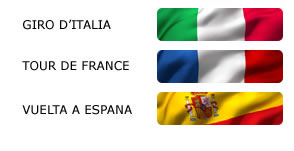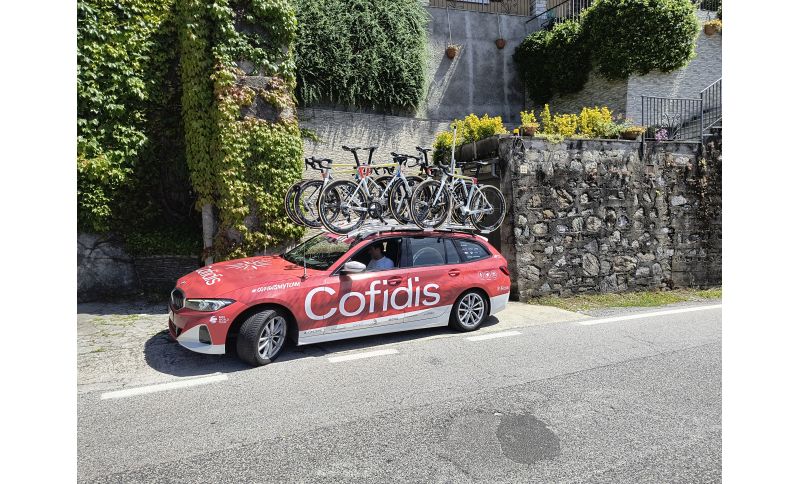On our social media
you can watch a reel that captures
the experience we had yesterday in the second Cofidis team car, which preceded the race until the first KOM, leaving almost half an hour before the official start and then positioning itself at the back of the
maglia rosa group, during
stage number 18 of the Giro d'Italia.
The experience began in the bus parking area of the Morbegno trade fair zone, where all vehicles arrived late due to an accident that had congested the Valtellina roads.
Sports director Roberto Damiani immediately warns us: cycling is not mathematics, on paper today could be for sprinters but in the third week, with a first hilly section and many squads hunting for points and satisfaction, the breakaway can have its say and we'll try to get into it with Stefano Oldani. The team, which is without its sprinter Milan Fretin who was spared the last week in the first grand tour of his life, will keep its word.
There's then time to chat with osteopath Guido Sacerdote: a figure whose importance in France, and in other more northern latitudes compared to Italy, was understood a few years earlier compared to a certain Italian skepticism. We're talking about a sport that "forces" the body, not only in terms of endurance and explosiveness but also posture, and particularly the chest, often trapped in the grip of arms and shoulders.
And here's the start. No, not the 1:50 PM one. But the 1:25 PM start of "our" BMW: this way it can perform a reconnaissance of the initial race segment and provide valuable information to the rest of the team. In yesterday's specific case, wind at 8 km/h instead of the predicted 5. In short, when the riders start, they have a precise real-time situation overview thanks to the sports director who went ahead for reconnaissance.
So, the sports director. Driving the car we were assigned is a Basque colleague of Damiani: Gorka Gerrikagoitia. First a rider and then sports director of the original Euskaltel Euskadi, active from 1994 to 2013, he was one of those cyclists who, not having a super engine (his own words) must put particular intelligence into staying in the peloton. And for whom, therefore, the transition from bike to team car is almost natural. In a quick but heartfelt excursus that exudes love for the (cycling and non-cycling) culture of the País Vasco, Gorka recalls with bitterness the closure of that Euskaltel and tells with emotion the reopening in 2018 thanks to the commitment of Mikel Landa, then president of Fundación Euskadi: "It's thanks to Landa and those who worked with him that the Basque Country could once again cultivate its talents in professionalism, as happened to him, Bilbao, Castroviejo, the Izagirre brothers and many others in 'my' Euskaltel. You must know that cycling here can unite people of fiercely different ideologies..." and here we allow ourselves a comparison with Bartali avoiding civil war by winning the Tour de France. But we're digressing.
Gorka's present is called France, a country with a certain proximity to the Basque land: first Delko, then the return to the World Tour with Cofidis in 2022, where he found his colleague and friend Bingen Fernandez. Over the years, three Basque riders also arrived: Lastra, Izagirre (Ion) and Aranburu. Of these, 31-year-old Jonathan Lastra is here at the Giro. Yes, the Giro. Stage 18. First stop roadside, spraying on Lake Como/Lecco in its northeastern point coming from Valtellina. Mechanic Mickaël Mainguenaud promptly inflates the Vittoria tubeless tires of the Look 795 Blade RS bikes placed on top of the car: in the heat, tubeless can deflate and it's essential to keep them at the perfect pressure level. A child present roadside with his dad and their camper takes the opportunity to ask for a cap: unfortunately, there are none in the car, he politely apologizes for the disturbance and returns to his steps. One of the aspects that will impress us most will not only be the number of people who, as the team cars pass, greet them affectionately and some encourage them as if they were riders (we swear we clearly heard a fan shouting "Go, alé Cofidis, come on come onnn") but also all those asking for caps and water bottles, some even with enthusiastic aggressiveness.
In any case, we soon set off again and climb the first and most challenging hill. A UAE car overtakes us, Gorka exchanges a quick Basque greeting with Matxin (who shortly after will see Ayuso forced to withdraw) and on the small TV in the auto we follow the first attacks for the breakaway. "See how many teams want to get into it? Considering this and the fact that the last part is flat, yes, but mostly inside a very technical city circuit, they won't arrive in a compact group today. Stages are often 'categorized' only based on altitude profile, but the route layout must also be evaluated..."
This won't be Gorka's last accurate prediction. Indeed, here's another: "These first 15 who have escaped won't go far." In fact, shortly after they are caught. We go up and down the first half of the route's difficulties, encountering splendid audience frameworks and banners and writings for the Giro heroes, especially local favorites like Valtellinese Piganzoli and Larian Petilli, both on the climbs and in inhabited centers. There's also time for a fleeting whispered comment that naturally springs from the Basque sports director: "My goodness, how Pedersen is going!"
In the end, the right breakaway comes: there are even 35 riders. Cofidis is represented by one man. Guess who: Oldani. The strategy set in the technical bus meeting has been correctly applied. Now it's up to his head and legs to transform it into something more.
At this point, however, we stop: Damiani's team car will go behind the breakaway and we will "slide" to the back of the peloton, which will let them go and conserve energy for the two big stages ahead. Here another stage begins for us. The VeloViewer screen will mark a increasingly distant mileage compared to the race's, in parallel with the breakaway's advantage expanding. In the two feed zones, we receive material not taken by the riders. Listening to Radiocorsa, interspersed with Damiani's instructions to his riders (we discover, however, that not all are heard by the rest of the team: some are directed solely to the athletes) will no longer focus on hearing the dorsals of the escapees, but on calls to team cars to move up and assist the rider who requested it.
No mechanical problems in the group for Cofidis, only water bottles and ice to pass. This happens on four occasions: once to Lastra, once to Anthony Perez, once to Pedro Samitier (possible escapee for one of the two upcoming stages, legs permitting) and once to Sylvain Moniquet. In these moments, the "sport apart" of driving in the race emerges in adrenalinic splendor: you know those videos showing passenger reactions with a professional driver driving on a track? More or less what happens to us in those moments, with the additional difficulty of team car traffic, and eventual rear riders, to be overcome with horn honks and sudden speed and direction changes. To us novices of the team car, it seems we're risking 3-4 rear-end collisions, but we rationally know everything is calculated. Watch our reel to believe.
"We're used to it now, it's normal to have to drive like this" Gorka tells us with the same confidence with which he delivers another of his spot-on verdicts. When we see that the small TV signal sometimes acts up, we say "Maybe for the final 3 kilometers I'll turn on the race on my cell phone so we're sure to follow the sprint between the escapees well". His reply: "They won't sprint among themselves anyway". From our side, silent assent.
We're now in the plains of Brianza, Gorka takes the opportunity to eat a sandwich while driving, obviously without losing control of the powerful vehicle, and Radiocorsa instructs the team cars preceding the race to "follow Garosio's instructions (yes, the Garosio who until last year was racing) and take the deviation to free up space in the final circuit". Meanwhile the escapees, as anticipated by Gorka, have broken up and only 11 remain ahead. Oldani is not among them. Who, however, as a subsequent radio information states, is among those selected for anti-doping.
The atmosphere becomes more taciturn: it's now clear that their designated man, though good at getting into the breakaway, won't be able to fight for the victory. Among the leaders is Edmondson from Picnic PostNL, the team fighting with Cofidis for the fateful 18th place in the three-year ranking for World Tour permanence. It will be a fierce battle until the end of the season, a strenuous defense of the top category for the team that has existed since 1997 and has always been called only Cofidis: a highly respectable value in a sport that depends on sponsorships and where teams change name very often.
End of the stage: with 16 km to go, Nico Denz takes off and Gorka pronounces, with the air of someone watching a movie they've already seen: "He's won". Correct, why would I tell you otherwise. For Oldani, a nonetheless honorable 20th place. For Cofidis, the iron will to close the Giro equally honorably (and who knows, maybe even surprise!) and launch themselves towards the next objectives for the fateful point collection: particularly delicate July, with the Tour de France which for them is the home grand tour, and for which they should count, among others, on Teuns for climbs, Coquard for sprints, Aranburu for mixed routes...
For us, a couple of final flash contributions to be transformed into social content: interview with Gorka once we've reached the bus parking, a brief illustration of the Look bikes by mechanic Nicolas Daniel. With gratitude for having lived from the inside what, even as professionals, we tend to tell almost always from the outside.




Se sei giá nostro utente esegui il login altrimenti registrati.